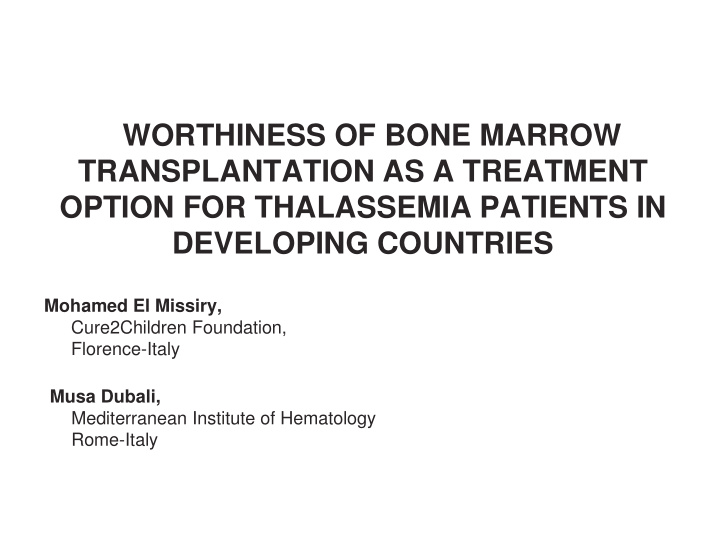



WORTHINESS OF BONE MARROW TRANSPLANTATION AS A TREATMENT OPTION FOR THALASSEMIA PATIENTS IN DEVELOPING COUNTRIES Mohamed El Missiry, Cure2Children Foundation, Florence-Italy Musa Dubali, Mediterranean Institute of Hematology Rome-Italy
Introduction • Thalassemia is a type of hemoglobinopathy due to either decreased or absent normal globin components (β - globin, α -globin) • Conventional treatment consists of: Blood transfusion to correct anemia chelation therapy for transfusion-associated iron load Treatment of other complications resulting from either anemia or iron overload. e.g. heart failure, viral Infections, and endocrinopathies
Examples • In Egypt carrier rate : up to 9% estimate of 1,000/1.5 million per year live births suffers from thalassemia . • In Albania: o about 300 thousand carriers ( 9-8% of population) • Global disease burden ~ 1 million (concentrated in developing countries).
Problem: ( Disease > Recourses )….. • Continuing supportive care costs: o 25,400 euros per year in Albania, and o 12,300 euros per year in Egypt • Albania has a shortage of facilities for supportive care: • Lack of blood (blood not always available to patients) • Treatment costs approaches European standards. • In Egypt : • Not enough resources to manage increasing patient load . • High carrier rate with lack of efficient preventive program. • HSCT demand exceeds current centres capacity; priority is given to urgent malignant cases.
Solution….(HSCT?) • First BMT for a thalssemia case done in the 1980 ’s . • Stem cell transplantation is the only conclusive cure for thalssemia: • Young ages with disease complications is still minimal. • Matched related donors (more likely due to large family size) • BMT greatly improves the quality of life for both patients and families by decreasing medical, psychological and financial burdens of continuous treatment.
Vision…. • The experience of the Cure2Children Foundation-supported BMT networks in developing countries, namely, in Pakistan and India: o cooperation programs with local institutions. o training of local health professionals o Long-term assisted follow up (easier to maintain in patient’s home country than travelling abroad) o BMT-associated prevention program. • Hospital infection control: Probably more important and cost-effective than air filtration (HEPA) and positive pressure: Hand washing and disinfection Easily cleanable room Dry environment Surfaces and air sample monitoring
• Protocol used ( Lucarelli’s regimen 6.1): Thiotepa (10mg/kg) Oral busulfan (14mg/kg) Cyclophosphamide (200 mg/kg) • For GVHD prophylaxis: - Triple drug (prednisone/methotrexate/cyclosporin)
Outcome.... • Low-risk matched-related BMT in children younger than 6 years and liver less than 2 cm could deliver: o 92% thalassemia-free survival o with 100% performance score o no extensive chronic GVHD, Analysis of 12 initial cases performed in 2 start up institutions o no Aspergillosis within a close cooperation program. Median follow-up: 7.5 months (3.5.33.5) o average cost:10.000-15.000 USD
Conclusions Curing thalassemia in early age with once-in-a-life bone marrow transplantation can be the solution for long- standing health and financial suffering from the disease. In young children with a compatible donor high cure rates can be achieved in developing countries within close cooperation programs... ...and cost-effectively!
Take home message... Promote awareness of BMT also in needy communities.... it could be more accessible and effective than many people think!
THANK YOU!
Recommend
More recommend